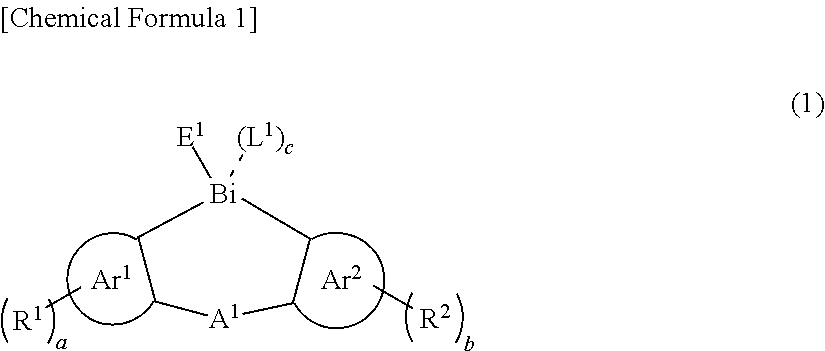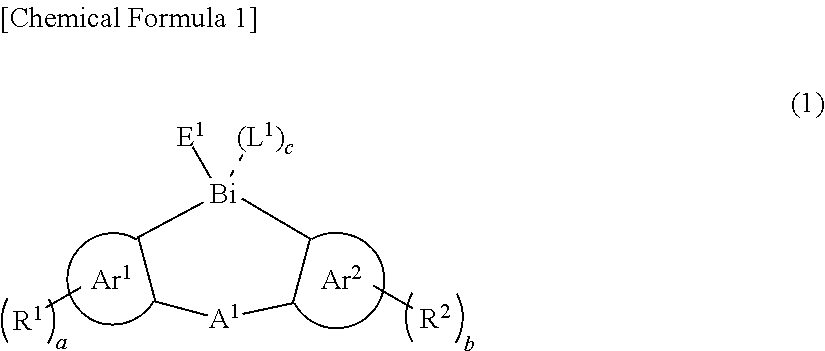Thin film and compound used in the same
a technology of thin film and compound, applied in the field of thin film, can solve the problem of high price of iridium, and achieve the effects of low toxicity, small burden on the environment, and excellent light-emitting characteristics
- Summary
- Abstract
- Description
- Claims
- Application Information
AI Technical Summary
Benefits of technology
Problems solved by technology
Method used
Image
Examples
synthesis example 1
Synthesis of 1-phenyl-3,6-bis(trimethylsilyl)dithienobismole
[0225]
[0226]The above synthetic reaction was effected according to the following procedure to synthesize 1-phenyl-3,6-bis(trimethylsilyl)dithienobismole. In the formula, TMS is a trimethylsilyl group.
[0227]Into a 30 mL two-neck flask equipped with a reflux condenser, 0.446 g (0.952 mmol) of 4,4′-dibromo-2,2′-bis(trimethylsilyl)bithiophene and 10 mL of ether were charged and the resultant reaction mixture was cooled down to −80° C. Thereto, 1.25 mL (1.59 M hexane solution, 1.98 mmol) of n-butyl lithium was added and the temperature of the resultant reaction mixture was returned gradually to room temperature, followed by stirring the reaction mixture for around 1 hour. About 0.2 mL of the reaction mixture was sampled and the sample was hydrolyzed, followed by subjecting the hydrolyzed sample to GC (gas chromatography) to confirm the generation of a dilithiated body. On the other hand, into a 30 mL two-neck flask equipped with...
synthesis example 2
Synthesis of 1-phenyl-2,7-dimethyl-3,6-bis(trimethylsilyl)dithienobismole
[0231]
[0232]The above synthetic reaction was effected according to the following procedure to synthesize 1-phenyl-2,7-dimethyl-3,6-bis(trimethylsilyl)dithienobismole.
[0233]Into a 10 mL two-neck flask, 0.468 g (1 mmol) of 4,4′-dibromo-3,3′-dimethyl-2,2′-bis(trimethylsilyl)bithiophene and 5 mL of ether were charged and the resultant reaction mixture was cooled down to −80° C. Thereto, 1.27 mL (1.56 M hexane solution, 2 mmol) of n-butyl lithium was added and the temperature of the resultant reaction mixture was returned gradually to room temperature, followed by stirring the reaction mixture for around 1 hour. About 0.2 mL of the reaction mixture was sampled and the sample was hydrolyzed, followed by subjecting the hydrolyzed sample to GC to confirm the generation of a dilithiated body. On the other hand, into a 20 mL Schlenk tube equipped with a dropping funnel, 5 mL of THF and 0.540 g (1 mmol) of diiodophenyl bi...
synthesis example 3
Synthesis of 1-phenyl-2,4-di(benzo[b]thieno)bismole
[0237]
[0238]The above synthetic reaction was effected according to the following procedure to synthesize 1-phenyl-2,4-di(benzo[b]thieno)bismole.
[0239]Into a 20 mL Schlenk tube, 0.424 g (1.00 mmol) of 3,3′-dibromo-2,2′-bi(benzo[b]thiophene) and 5 mL of ether were charged and the resultant reaction mixture was cooled down to −80° C. Thereto, 1.27 mL (1.56 M hexane solution, 2.00 mmol) of n-butyl lithium was added and the temperature of the resultant reaction mixture was returned gradually to room temperature, followed by stirring the reaction mixture for around 1 hour. By GC, the generation of a dilithiated body was confirmed. Thereinto, 0.540 g (1.00 mmol) of diiodophenyl bismuth dissolved in 5 mL of THF was dropped at 0° C. and the resultant reaction mixture maintained at 0° C. was stirred over one night. By TLC, the disappearance of the substrate was confirmed. From the reaction mixture, the solvent was distilled off by an evaporat...
PUM
| Property | Measurement | Unit |
|---|---|---|
| thickness | aaaaa | aaaaa |
| triplet excitation energy | aaaaa | aaaaa |
| composition | aaaaa | aaaaa |
Abstract
Description
Claims
Application Information
 Login to View More
Login to View More - R&D
- Intellectual Property
- Life Sciences
- Materials
- Tech Scout
- Unparalleled Data Quality
- Higher Quality Content
- 60% Fewer Hallucinations
Browse by: Latest US Patents, China's latest patents, Technical Efficacy Thesaurus, Application Domain, Technology Topic, Popular Technical Reports.
© 2025 PatSnap. All rights reserved.Legal|Privacy policy|Modern Slavery Act Transparency Statement|Sitemap|About US| Contact US: help@patsnap.com



